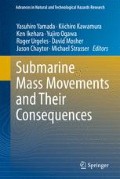Abstract
The Pacific Margin of Costa Rica is an area of intense tectonic deformation and repeated slope instability. Several processes are assumed to affect the long-term stability of the slope. Convergence-related seamount subduction and erosion are the primary reasons for large-scale failures at the lower slope. A second type of smaller slope failures occurs on the upper slope coincident with the landward termination of the regional Bottom Simulating Reflector (BSR). The coincidence of the BSR boundary and the position of slide headwalls might suggest a close genetic relationship. In this paper we present a detailed analysis of the so called “BGR Slide”, a small-type submarine landslide located on the upper slope offshore the Golfo de Nicoya. The 60 m-high headwall is embedded in an area characterized by small canyon structures on the continental slope in water depths where the regional BSR reaches the sea floor. The slide with a volume of ∼0.3 km³ affected an area of ∼8 km². Our acoustic data set suggest faults and migrating fluids playing key roles as preconditioning factors for slope failure, while there is no clear indication for the occurrence of gas hydrates in the headwall region. Furthermore, we assume that an external trigger, e.g., an earthquake, finally initialized the sediment mobilization.
Access this chapter
Tax calculation will be finalised at checkout
Purchases are for personal use only
References
Brückmann W, Rhein M, Rehder G et al (eds) (2009) SUBFLUX Cruise No 66 August 12–December 22 2005. METEOR-Berichte 09-2. Universität Hamburg, 158 pp. ISSN 0 9 3 6 – 8 9 5 7
DeMets C, Gordon RG, Argus DF et al (1994) Effect of recent revisions to the geomagnetic reversal time scale on estimates of current plate motions. Geophys Res Lett 21:2191–2194
Grozic JLH (2010) Interplay between gas hydrates and submarine slope failure. In: Mosher DC, Baxter CDP, Urgeles R et al (eds) Submarine mass movements and their consequences. Springer, Dordrecht
Holbrook WS, Hoskins H, Wood WT et al (1996) Methane hydrate and free gas on the Blake Ridge from vertical seismic profiling. Science 273(5283):1840–1843
Hühnerbach V, Masson DG, Bohrmann G et al (2005) Deformation and submarine landsliding caused by seamount subduction beneath the Costa Rica continental margin – new insights from high-resolution sidescan sonar data. In: Hodgons DM, Flint SS (eds) Submarine slope systems: processes and products. Geological Society Special Publications 244, London, pp 195–205
Mienert J, Vanneste M, Bünz S et al (2005) Ocean warming and gas hydrate stability on the mid-Norwegian margin at the Storegga slide. Mar Petrol Geol 22(1–2):233–244
Paul CK, Ussler W III, Dillon WP (2000) Potential role of gas hydrate decomposition in generation submarine slope failures. In: Max M (ed) Natural gas hydrate in marine and permafrost environments. Kluwer, Dordrecht, pp 149–156
Ranero CR, von Huene R (2000) Subduction erosion along the Middle America convergent margin. Nature 404:748–752
Sahling H, Masson DG, Ranero CR et al (2008) Fluid seepage at the continental margin offshore Costa Rica and southern Nicaragua. Geochem Geophys Geosyst 9:Q05S05. doi:10.1029/2008GC001978
Sultan N, Cochonat P, Foucher JP et al (2004) Effect of gas hydrates melting on seafloor slope instability. Mar Geol 213:379–401
von Huene R, Ranero CR, Weinrebe W (2000) Quaternary convergent margin tectonics of Costa Rica, segmentation of the Cocos Plate, and Central American volcanism. Tectonics 19:314–334
von Huene R, Ranero CR, Watts P (2004) Tsunamigenic slope failure along the Middle American Trench in two tectonic settings. Mar Geol 203:303–317
Acknowledgment
The authors want to thank the captain and crew of RV Sonne during research cruise SO 206. We also thank Frank Strozyk and Kathrin Huhn for constructive comments, which improved the manuscript. Funding was provided by the DFG.
Author information
Authors and Affiliations
Corresponding author
Editor information
Editors and Affiliations
Rights and permissions
Copyright information
© 2012 Springer Science+Business Media B.V.
About this paper
Cite this paper
Anasetti, A., Winkelmann, D., Krastel, S., Bialas, J., Brückmann, W. (2012). The BGR Slide Off Costa Rica: Preconditioning Factors, Trigger, and Slide Dynamics. In: Yamada, Y., et al. Submarine Mass Movements and Their Consequences. Advances in Natural and Technological Hazards Research, vol 31. Springer, Dordrecht. https://doi.org/10.1007/978-94-007-2162-3_26
Download citation
DOI: https://doi.org/10.1007/978-94-007-2162-3_26
Published:
Publisher Name: Springer, Dordrecht
Print ISBN: 978-94-007-2161-6
Online ISBN: 978-94-007-2162-3
eBook Packages: Earth and Environmental ScienceEarth and Environmental Science (R0)

